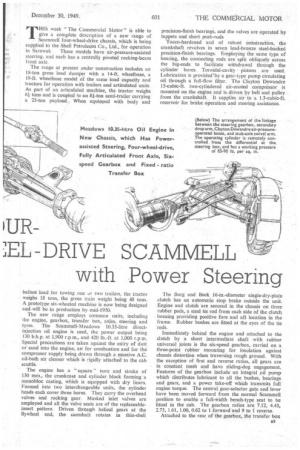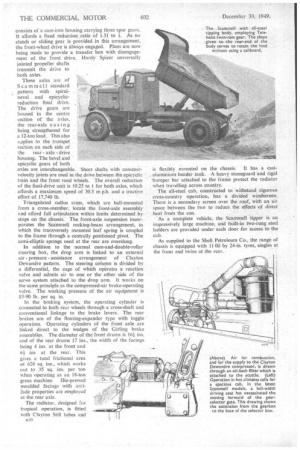NEW F 1UR WF EL-DRIVE SCAMMELL with Power Steering
Page 42

Page 43

Page 44

If you've noticed an error in this article please click here to report it so we can fix it.
THIS week "The Commercial Motor" is able to give a complete description of a new range of Scammell four-wheel-drive chassis, which is being supplied to the Shell Petroleum Co., Ltd., for operation
in Sarawak These models have air-pressure-assisted steering, and each has a centrally pivoted rocking-beam front axle.
The range at present under construction includes an 18-ton gross load dumper with a 14-ft. wheelbase, a 19-ft. wheelbase model of the same load capacity and tractors for operation with trailers and articulated units. As part of an articulated machine, the tractor weighs 6i tons and is coupled to an 81-ton semi-trailer carrying a 25-ton payload. When equipped with body and ballast load for towing one o: two trailers, the tractor weighs 18 tons, the gross train weight being 48 tons. A prototype six-wheelcd machine is now being designed and will be in production by mid-1950.
The new range employs common units, including the engine, gearbox, transfer box, axles, steering and tyres. The Scammell-Meadows 10.35-litre directinjection oil engine is used, the power output being 130 b.h.p. at 1,900 r.p m., and 420 lb.-ft. at 1,000 r.p.m. Special precautions are taken against the entry of dust or sand into the engine, air for combustion and for the compressor supply being drawn through a massive A.C. oil-bath air cleaner which is rigidly attached to the cab scuttle.
The engine has a "square " bore and stroke of 130 mm., the crankcase and cylinder block forming a monobloc casting, which is equipped with dry liners. Formed into two interchangeable units, the cylinder heads each cover three bores. They carry, the overhead valves • and rocking gear. Masked inlet valves are employed and all the Valve seats are of the replaceableinsert pattern. Driven through helical gears at the flywheel end, thecamshaft rotates in thin-shell
precision-finish bearings, and the valves are operated by tappets and short push-rods
Tocco-hardened and of robust construction, the crankshaft revolves in seven lead-bronze steel-backed precision-finish bearings. Employing the same type of bearing, the connecting rods are split obliquely across the big-ends to facilitate withdrawal through the cylinder bores. Toroidal-cavity pistons are used. Lubrication is provided'hy a gear-type pump circulating oil through a full-flow filter. The Clayton Dewandre 15-cubic-ft. two-cylindered air-cooled compressor is mounted on the engine and is driven by belt and pulley from the crankshaft. It supplies air to a 1.3-cubic-ft. reservoir for brake operation and steering assistance.
The Borg and Beck I6-in.-diameter single-dry-plate clutch has an automatic stop brake outside the unit. Engine and clutch are secured in the chassis on three rubber pads, a steel tie rod from each side of the clutch housing providing positive fore and aft location in the frame. Rubber bushes are fitted at the eyes of the tie rods.
Immediately behind the engine and attached to the clutch by a short intermediate shaft with rubber universal joints is the six-speed gearbox, carried on a three-point rubber mounting for insulation against chassis distortion when traversing rough ground. With the exception at first and reverse ratios, all gears are in constant mesh and have sliding-dog engagement. Features of the gearbox include an integral oil pump which distributes lubricant to all the bushes, bearings and gears, and a power take-off which transmits full engine torque. The central gear-selector gate and lever have been moved forward from the normal Scammell position to enable a full-width bench-type seat to be fitted in the cab. The gearbox ratios are 7.12, 4.43, 2.75, 1.61, 1.00, 0.62 to 1 forward and 9 to 1 reverse.
Attached to the rear of the gearbox, the transfer box consists of a cast-iron housing carrying three spur gears. It affords a fixed reduction ratio of 1.31 to 1. As no clutch or sliding gear is provided in this arrangement, the front-wheel drive is always engaged. Plans are now being made to provide a transfer box with disengagement of the front drive. Hardy• Spicer universally jointed propeller shafts transmit the drive to both axles.
These axles are of Scammell standard pattern with spiralbevel and epicyclicreduction final drive. The drive gears are housed in the centre section of the axles, the rear-axle casing being strengthened for a 12-ton load. This also applies to the trumpet section on each side of
the rear axle-drive housing. The bevel and epicyclic gears of both
axles are interchangeable. Short shafts with constantvelocity joints are used in the drive .between the epicyclic train and the front road wheels. The overall reduction of the final-drive unit is 10.25 to 1 for both axles, which affords a maximum speed of 30.5 m p.h. and a tractive effort of 17,740 lb.
Triangulated radius arms, which are ball-mounted from a cross-member, locate the front-axle assembly and afford full articulation within limits determined by stops on the chassis. The front-axle suspension incorporates the Scam-tell rocking-beam arrangement, in which the transversely mounted leaf spring is coupled to the frame through a centrally positioned pivot. The semi-elliptic springs used at the rear are overslung.
In addition to the normal earn-and-double-roller steering box, the drop arm is linked to an external air pressure assistance arrangement of Clayton Dewandre pattern. The steering column is divided by a differential, the cage of which opierates a reaction valve and admits air to one or the other side of the servo system attached to the drop arm. It works on the same principle as the compressed-air brake-operating valve. The working pressure of the air equipment is 85-90 lb. per sq. in.
In the braking system, the operating cylinder is connected to both rear wheels through a cross-shaft and conventional linkage to the brake levers. The rear brakes are of the floating-expander type with toggle operation. Operating cylinders of the front axle are linked direct to the wedges of the Girling brake assemblies. The diameter of the front drums is 164 ins. and of the rear drums 17 ins., the width of the facings being 4 ins, at the front and 6i ins at the rear. This gives a total frictional area of 628 sq. ins., which works out to 35 sq. ins, per ton when operating as an 18-ton gross machine. Die-pressed moulded facings with antifade properties are employed at the rear axle.
The radiator, designed for tropical operation, is fitted with Clayton Still tubes and RIO is flexibly mounted on the chassis. It has a cast aluminium header tank. A heavy stoneguard and rigid bumper bar attached to the frame protect the radiator when travelling across country.
The all-steel cab, constructed to withstand rigorous cross-country operation, has a divided windscreen. There is a secondary screen over the roof, with an air space between the two to reduce the effects of direct heat from the sun.
As a complete vehicle, the Scammell tipper is an impressively large machine, and built-in two-rung steel ladders are provided under each door for access to the cab.
As supplied to the Shell Petroleum Co., the range of chassis is equipped with 11 00 by 24-in. tyres, singles at the front and twins at the rear.




















































































